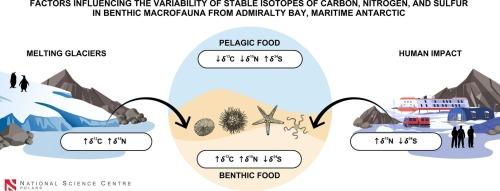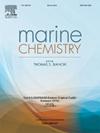Factors influencing the variability of stable isotopes of carbon, nitrogen, and sulfur in benthic macrofauna from Admiralty Bay, maritime Antarctic
IF 2.5
3区 地球科学
Q2 CHEMISTRY, MULTIDISCIPLINARY
引用次数: 0
Abstract
This study examines benthic macrofauna from Admiralty Bay, maritime Antarctic, using triple stable isotope approach (δ13C, δ15N, and δ34S) to assess the impact of melting glaciers and human activity on trophic interactions in this unique ecosystem. Four species – the limpet Nacella concinna, the sea urchin Sterechinus neumayeri, the starfish Odontaster validus, and the brittle star Ophionotus victoriae – were analyzed to characterize their isotopic composition and trophic niches. The results indicate that diet and feeding strategies were the main drivers of δ13C, δ15N, and δ34S variability, demonstrating the utility of a multi-isotope approach for revealing diet composition, trophic plasticity, and benthic–pelagic coupling in polar benthic communities. Elevated δ13C values, typical of benthic primary producers, and depleted δ34S values, indicative of sulfur derived from sediments, confirmed a strong reliance of benthic macrofauna on benthic food sources. In contrast, decrease in δ13C together with higher and typically marine δ34S, can indicate higher contribution of pelagic diet sources. Spatial isotopic patterns further revealed areas influenced by glacial melt and shifting ice conditions, where consumers were relatively enriched in δ13C and δ15N compared to sites with rather open-ocean conditions. Notably, δ34S emerged as a possible early indicator of human-related disturbance, with depletion reflecting increased anthropogenic sulfur inputs and reduced oxygen conditions in benthic habitats linked to nutrient enrichment. Concurrent to 34S-depletion enrichment in 15N supports the role of nitrogen inputs from human activities. These findings demonstrate that stable isotopic tracers, particularly when incorporating sulfur alongside carbon and nitrogen, provide a powerful tool to detect and interpret ecological responses to both natural and anthropogenic drivers, offering insights into local ecosystem shifts and their broader implications for Antarctic food webs under climate change and growing human pressure.

影响南极海相金钟湾底栖大型动物碳、氮、硫稳定同位素变异的因素
本研究利用三稳定同位素方法(δ13C、δ15N和δ34S)分析了南极海洋金钟湾的底栖大型动物,评估了冰川融化和人类活动对这一独特生态系统营养相互作用的影响。本文分析了四种海洋生物(帽贝、海胆、海星、蛇尾海星)的同位素组成和营养生态位特征。结果表明,饮食和取食策略是极地底栖生物群落δ13C、δ15N和δ34S变化的主要驱动因素,证明了多同位素方法在揭示极地底栖生物群落的饮食组成、营养可塑性和底-上层耦合方面的效用。δ13C值升高是底栖生物初级生产者的典型特征,δ34S值下降表明沉积物中含有硫,这证实了底栖大型动物对底栖动物食物来源的强烈依赖。δ13C降低,δ34S较高,且典型为海洋δ34S,说明上层海洋饮食源的贡献较大。空间同位素模式进一步揭示了受冰川融化和移动冰条件影响的地区,与相对开放的海洋条件相比,这些地区的消费者δ13C和δ15N相对丰富。值得注意的是,δ34S可能是人类相关干扰的早期指标,其耗竭反映了与养分富集有关的底栖生物栖息地中人为硫输入增加和氧气条件降低。与34s耗竭同时发生的15N富集支持人类活动氮输入的作用。这些发现表明,稳定的同位素示踪剂,特别是将硫与碳和氮结合在一起的示踪剂,为检测和解释对自然和人为驱动因素的生态反应提供了强有力的工具,为了解当地生态系统的变化及其在气候变化和日益增长的人类压力下对南极食物网的更广泛影响提供了见解。
本文章由计算机程序翻译,如有差异,请以英文原文为准。
求助全文
约1分钟内获得全文
求助全文
来源期刊

Marine Chemistry
化学-海洋学
CiteScore
6.00
自引率
3.30%
发文量
70
审稿时长
4.5 months
期刊介绍:
Marine Chemistry is an international medium for the publication of original studies and occasional reviews in the field of chemistry in the marine environment, with emphasis on the dynamic approach. The journal endeavours to cover all aspects, from chemical processes to theoretical and experimental work, and, by providing a central channel of communication, to speed the flow of information in this relatively new and rapidly expanding discipline.
 求助内容:
求助内容: 应助结果提醒方式:
应助结果提醒方式:


